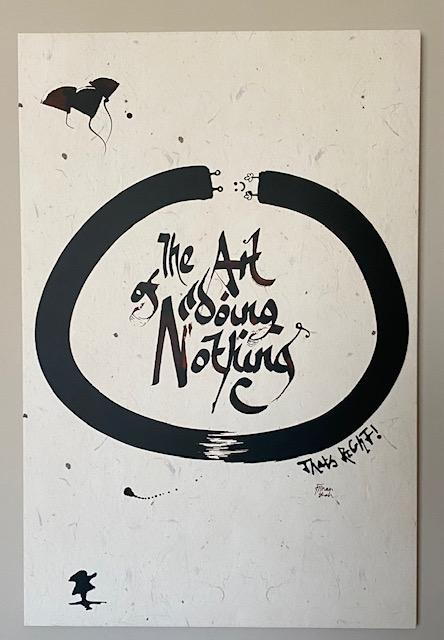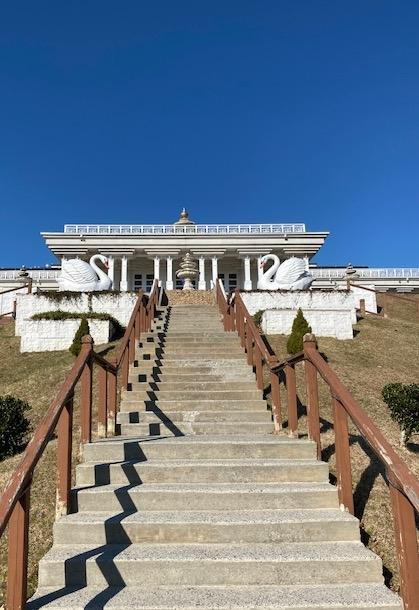
‘Doing nothing is better than being busy doing nothing.’ — Lao Tzu
A couple of weeks ago I went on a five-day silent retreat in the mountains of North Carolina. I was hoping to take some time alone with my thoughts to rest and recharge (which is the same advice I’ve often shared with my coaching clients). The Stepping Into Silence retreat sounded blissful. After all, how often are we able to step away from work and life for the sole purpose of just feeling for a few days? I was excited — my husband was skeptical.
“How are you going to be silent for 3 whole days when you can’t even stay quiet for 3 minutes?!” he said.
I was no stranger to retreats and was ready to step up to the challenge of a silent retreat. I envisioned that this one wouldn’t be all that different from others I’ve attended: we’d do a digital detox, maybe follow a vegan diet, practice some yoga, and of course, this time, stay silent.
So imagine my surprise when, in the middle of Day 2, our instructor informed us that for the next 72 hours, we would practice the Art of Doing Nothing.
 Author Photo of The Art of Doing Nothing
Author Photo of The Art of Doing Nothing
The art of doing nothing, our instructor explained, meant no distractions for your mind. Aside from no talking, it also meant:
No writing.
No reading.
No music.
No technology.
No strenuous exercise.
Just be.
For 72 hours.
All of a sudden the three books and writing journals I’d brought with me seemed pretty useless. I’d planned on spending relaxing mornings writing in my journal while I sipped a latte overlooking the mountains. Now, it appeared I’d get to keep the lattes but not much else.
That night, once I realized the full extent of what I’d committed to, I panicked a bit. But I had paid for this experience, I was already there, and I wasn’t about to squander it.
So I did my best to practice what the instructors preached: I attempted to be present and stay in the moment. Rather than stress about how I was going to be alone with my thoughts for three whole days or bemoan the things I would no longer be able to do, I decided to take it one moment at a time. Those moments turned into hours, which eventually turned into days.
Of course, we did have some activities planned. There was a yoga practice every morning, along with three daily meditation sessions and occasional lectures. We enjoyed three (silent) meals a day and had access to nature and hiking trails nearby.
The sessions themselves were educational and inspiring. Although the retreat attendees couldn’t speak or communicate nonverbally (e.g., a weighted look in someone else’s direction), we could write out any questions that arose during the day and drop them in a Question Box. At the beginning of each session, the instructor began by answering those questions.
At first, the questions were mostly ‘Can I…?’ questions (often tinged with a hint of agitation and panic-affiliated) like:
“I’m feeling really anxious. The only thing that helps is playing my guitar. Is it breaking the silence if I play my guitar without singing?” (Yes)
“Can I write in my journal to process my experience here?” (No)
“I have the constant urge to check my phone for messages to see if my kids need me. What can I do?” (Assuming your family knows you are here, they will call the office if there is an emergency, and we will find you.)
Of course, the instructor also told us that we could do whatever we wanted. No one would stop us from speaking, reading, or playing the guitar. But he gently reminded us that we came there for a reason (and paid money to be there). He asked us how we’d feel at the end of the retreat if we weren’t able to keep our silence.
By the second day, those types of questions stopped. As we learned and practiced various breathing techniques before our meditations, the questions became more procedural.
“How many inhalations do I do for long-form breathing?”
“Is it normal to feel lightheaded during SKY breathing?”
“How do I keep my thoughts from wandering during meditation?”
By the last day of the silence, as we became more adept at deeper and longer meditation sessions, we listened to lectures from Gurudev Sri Sri Ravi Shankar, The Art of Living Founder. They addressed issues such as consciousness, death, and Buddhism principles. The questions became deeper:
“What does dispassion mean, and how do I apply it?”
“What happens to our consciousness upon death?”
Nineteen of us shared those five days in the mountains of North Carolina. I was on a yoga mat with a meditation chair, bolster, and blanket for a total of 26 hours, 15 sessions, and 5 days, separated from my closest ‘neighbors’ by 6 feet….and I never learned their names or their backgrounds, or what brought them to this retreat. Yet I felt like I knew them better than colleagues, neighbors, and acquaintances that I had interacted with superficially for years. It’s amazing how attuned your senses become when you are limited in what you can do. Noises, smells, and careful observations I never would have noticed had become my ‘normal’ mode of thinking and doing for a short period of time.
The power of a silent retreat is to be left alone with your thoughts until you haven’t got many thoughts left at all.
After a certain amount of time, our inner voice — the one that never seems to stop — quiets. For many, it even disappears completely for a bit. That is silence. For me, it was like the longest and best night’s sleep I’d ever had.
Silent retreats are not for everyone. But if you are a seeker, enjoy meditation, and want a challenge to go deeper into your soul, then I would recommend trying one.
 Author Photo, Art of Living Retreat Center
Author Photo, Art of Living Retreat Center
The Benefits of Silence — Backed by Science
The Art of Doing Nothing is a practice that is backed by science. It often feels as though the world has become louder, our pace more frenetic, our distractions more constant. Are we, as a human race, losing the practice of being silent?
If so, we should work to get it back. Here’s why:
- A 2013 study on adult mice found that two hours of silence per day prompted cell development in the hippocampus, the brain region related to the formation of memory.
- Noise can have a pronounced physical effect on our brains resulting in elevated levels of stress hormones. Research shows that children who are exposed to prolonged noise may develop a stress response that causes them to ignore lots of different noises, including bad (disruptive) noise but also good noise, like someone speaking to them.
- An article published in the Journal of Environmental Psychology argues that, “In silence, the brain is able to let down its sensory guard and restore some of what has been ‘lost’ through excess noise.”
- Additional research shows that a silent rest state is incredibly beneficial for the brain. “Quiet time” gives your brain the freedom to process things in a more profound, imaginative way.
The phrase “Silence is golden” exists for a reason. But humans aren’t always comfortable being alone with our thoughts. In fact, one study asked participants to put away any and all distractions and entertain themselves with their own thoughts for 15 minutes. In one such study, they provided participants with the option to shock themselves during the period of silence. 25% of the female participants and an incredible 66% of the male participants willingly shocked themselves during that period — assumedly as a bizarre form of “entertainment” during their extended boredom.
We know that silence can be beneficial. But we also know that staying silent can be really, really hard. So what do we do?
One Step at a Time
Achieving a state of silence and relaxation is not easy. It takes work — and lots of practice. But I encourage you to embrace the Italian concept of dolce far niente (“sweetness of doing nothing”). The concept refers to a period of idle rest and relaxation. It’s not the normal idea of “doing nothing” you might think you’re doing when you’re on the couch scrolling aimlessly through your phone. It’s an intentional practice that invites you to remain in the moment with as few distractions as possible.
So how do you practice stepping into silence in your own life?
- Leave your phone behind and take a quiet walk around the block. Take note of how you feel and what you observe.
- Try incorporating a short (5–10 minute) meditation (or period of no distractions and just being silent) into your day-to-day routine.
- Disconnect from technology for a few hours (or a whole day!).
- Sit outside on your porch and watch the sunrise or sunset.
Stepping into silence shouldn’t be a punishment. On the contrary, it should be an enjoyable experience that allows you to be fully present during life’s quiet moments.
Give it a try — you may like it more than you think.
